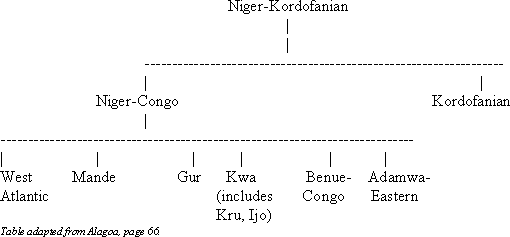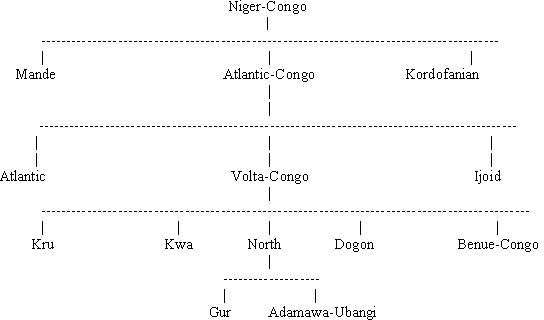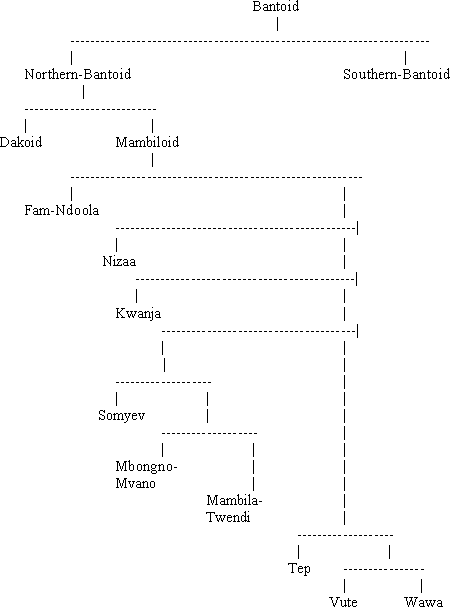|
Exploring the Niger-Congo Languages Gwenyth J. Lafleur
INTRODUCTION
EARLY CLASSIFICATIONS In 1826 Balbi regrouped the African languages into five geographical divisions: 1.) Nile, 2.) Atlas, 3.) Maritime Negro of Guinea and Senegambia, 4.) South African, 5.) Sudan and Interior Negro. Also in 1826 Prichard recognized that there was a certain unity of the Kaffrarian (or Bantu) Family to which he assigned all of the languages south of the Equator except for Hottentot (Bendor-Samuel 3-4). A major step was taken with the classification provided by Koelle and Bleek. Although their work left a number of languages unclassified, some of the groupings which they set up correspond to modern groups:
North-West Atlantic = (West) Atlantic Bleek was also fully aware of the unity of "that great family which, with the exception of the Hottentot dialects, includes the whole of South Africa, and most of the tongues of Western Africa" (Bendor-Samuel 4). Bleek named this family Bantu in 1858 and saw it as consisting of South African and West African divisions which correspond in outline to Niger-Congo. Bleek is also credited with distinguishing the Bantu languages from what are now called the Kordofanian languages (Fula, Wolof, Ga, Ukuafi and Tumale). At the time the Kordofanian languages were called the Gor languages. Bleek, even at this time, saw the similarities in the two sets of languages and considered them as related in some way. Scholars today have proven his theory correct by including the Bantu languages and the Kordofanian languages in the same language family (Bendor-Samuel 4). Although many of Bleek’s assertions were commonly accepted, the classification which would dominate the rest of the 19th century as well as the early 20th century was that of Friedrich Müller (1876-88). His classification tended to equate races with language families which led to Müller’s separation of "Negro" and Bantu languages from each other. Lepsius (1880), however, continued with Bleek’s distinction between the "prefix-pronominal" languages (of which Bantu was one of the purest examples) and the "Hamitic" languages which were "sex-denoting languages" (Bendor-Samuel 5). This separation of Bantu and Hamitic left a large number of languages referred to as "Mixed Negro Languages" due to the elements of both Bantu and Hamitic which were evident therein. Lespius was convinced that these languages were a result of the "great, partly hostile, partly peaceful, encounter between the original African [i.e., Bantu] and the intrusive Asiatic [i.e., Afro-Asiatic] languages" (Bendor-Samuel 5). Lepsius also noted that there was a group of languages which seemed to have only monosyllabic roots and traces of nominal prefixes. This group of languages is called Ewe or Gbe. The languages of this group have been reduced from more complex forms and are not simple or original. Schleicher (1891) referred to this group as "Semi-Bantu" meaning that they were languages which had not yet completely evolved to the status of a full Bantu language. Krause (1895) used the name Bantoid to represent a pre-Bantu stage of development (Bendor-Samuel 6). Meinhof used these Bantoid languages as a stepping stone for the application of the comparative method through which he constructed a proto-Bantu language (Bendor-Samuel 6). Westermann aided classifications with his influential studies of Sudanic languages. He studied "Eastern Sudanic" languages, which are now classified as Nilo-Saharan, and he also studied "Western Sudanic" which are now classified as Niger-Congo. Westermann made a more detailed study of "Western Sudanic" and tried to make some connections with the Bantu languages. He organized this group into six subfamilies: Kwa, Benue-Cross, Togo Remnant, Gur, West Atlantic, and Mandingo. Westermann also set up a large number of proto-West Sudanic roots and compared them with the proto-Bantu reconstructions of Meinhof and Bourquin (1923) (Bendor-Samuel 7). One of the most famous classifications is that of Greenberg. He used Westermann’s studies as a type of springboard to his own conclusions. Greenberg, however, made several divergences from previous studies in stating his own conclusion. Among these divergences are: 1) Westermann’s "West Sudanic" and Bantu formed a single genetic family which he named Niger-Congo, 2) Niger-Congo consisted of the following subfamilies recognized by Westermann: West Atlantic, Mande (Mandingo), Gur or Voltaic, Kwa (which included Togo Remnant) and Benue-Congo (Benue-Cross), 3) Bantu constituted a subgroup of a subgroup of Benue-Congo rather than being a subfamily like the others, and 4) Kordofanian, which he had treated as a separate family previously, was coordinate with Niger-Congo as a whole thus causing him to name the larger family Niger-Kordofanian (Bendor-Samuel 7-8). Greenberg’s groupings (1963) are shown below:
Greenberg arrived at these groupings using the following method: 1) he compared word lists of basic vocabularies from large numbers of languages and established cognates in some if not all of the languages of a particular grouping. Greenberg called this mass comparison. 2) he compared particular grammatical morphemes with similar forms and functions from one language to another and established relationships between them. Greenberg felt that is was a mistake to compare general features of languages "...without making a detailed comparison of the actual morphemes by which these systems were realized" (Bendor-Samuel 8). There have been questions by many scholars concerning the validity of Greenberg’s groupings. Greenberg himself raised several doubts when he suggested that the affiliation of Kru and Ijo to the Kwa group should be considered tentative and that Kwa and Benue-Congo are quite close to each other. He even goes so far as to say that there is legitimate doubt as to whether or not the two should be separated at all (Alagoa 66). These doubts were in turn raised by other scholars who then proposed a radical restructuring of the classification of the Niger-Congo family. There are several groups of researchers who have made efforts to either include the Niger-Congo family in an even larger family and there have been other researchers who have attempted to break up the subfamilies of the Niger-Congo group to create even more language families (Bendor-Samuel 9). Bender (1981) suggested "that we are on the verge of a realignment of African language phyla: Kongo-Saharan, including Niger-Kordofanian and Kadugli, and perhaps Omotic being members at some level: perhaps Mande-Songhay is a third major branch" (Bendor-Samuel 9). Although the concept of Kongo-Saharan is not yet considered gospel by those in the field, many who have looked at this question consider the relationship to be likely although full proof and the subclassification of the phylum remain to be determined (Bendor-Samuel 9). It may have been noted by this point that Niger-Congo and Niger-Kordofanian have both been used to indicate the same family. There was some uncertainty as to whether or not the Kordofanian family split off earlier than the Mande branch, thus the title Niger-Kordofanian. Now, however, it is generally agreed that Kordofanian did not split off earlier and the "raison d’être" for the term Niger-Kordofanian has disappeared. Niger-Congo has always been the most widely used term and it now appears that there are some objections to the term Kordofanian itself (Bendor-Samuel 19). The following classification was taken from Ethnologue and represents the most current grouping that I could find.
THE BRANCHES OF NIGER-CONGO
MANDE Comparative study of Mande languages began with word lists compiled by travelers. Westermann included Mande in his language family "West Sudanic" and also suggested that the Bantu languages were a part of this grouping. Greenberg placed Mande as one of six branches of Niger-Congo. Mande’s position as a part of the Niger-Congo family was soon decided to be precarious. Some argued that it did not belong in the family at all while others, including Welmers (1971) proposed that Mande was the first group to split off from the rest of the family. Welmers provided the first modern classification of Mande through the use of lexical comparison. Many linguists are skeptical of basing the classification on purely lexical evidence, but the Mande languages are today still a part of the Niger-Congo family (Bendor-Samuel 49-53).
KORDOFANIAN Until 1838 almost nothing was known about the Kordofanian languages. In this year, however, Duke Maximilian in Bavaria bought the freedom of four men on the slave market in Alexandria. One of these men was Djalo Djondan Are from Tumale and he, while studying with the Duke’s former tutor Karl Tutscheck, provided information about his people and language (Bendor-Samuel 67). There are four subgroups in the Kordofanian group: Heiban, Talodi, Rashad, and Katla. These four groups are non-controversial at this point in time. Greenberg had a fifth subgroup, Kordofanian, but it has since been excluded. It is not clear at this point whether the four groups should be regarded as primary branches of Kordofanian or whether there are intermediate levels of relationships which need to be recognized (Bendor-Samuel 71). The exact place of Kordofanian within Niger-Congo is less clear than is its general relation to it. "Regarding Kordofanian as one of three primary branches of Niger-Congo is the least speculative guess possible in the absence of specific investigations" (Bendor-Samuel 73). Schadeberg states that further research in this area is necessary. Kordofanian is presented as being related to the Niger-Congo family, but so far there are no particular links with any subgroup of that language family which have been discovered. There is evidence that Kordofanian has been spoken in its present location, the Nuba Mountains, for a long time. Some argue that Kordofanian represents the oldest linguistic layer in the Nuba Mountains - something to keep in mind when addressing the question of the origins of Niger-Congo (Bendor-Samuel 79).
ATLANTIC
IJOID Ijo is spoken in the Niger Delta and in adjacent "riverine areas" within the Rivers, Bendel, and Ondo States of Nigeria by approximately one million people. Ijo is usually spoken of as a single language; its speakers think of themselves as related and like to refer to the differences between the various forms of Ijo as differences of dialects. There is not, however, mutual intelligibility between all of the dialects nor is there an accepted standard variety for its speakers. As a result, it has been found to be for the best to treat Ijo as a language cluster containing seven languages, four isolated dialects, and three clusters of dialects (Bendor-Samuel 108).
KRU The classification of Kru within the Niger-Congo family remains tentative. In 1952, Westermann and Bryan listed Kru as a West African isolate. Greenberg tentatively included Kru in Kwa. More recent studies, like that of Vogler, attempt to show that Kru is closer to the Gur and Mande families than to Kwa. Bennett and Sterk placed Gur and Kru in the same subfamily while Welmers lists Kru as a separate branch of Niger-Congo. More research is needed in this area to determine what the exact relationship is between these three groups. Until a more substantial link can be established, the most conservative classification maintains the independence of the Kru group (Bendor-Samuel 121).
KWA
GUR Early knowledge of Gur languages came from explorers and missionaries. Up until the second World War, studies by linguists and anthropologists were more informative but often prejudiced. Westermann and Bryan had a clearer understanding and it was during this period, the 1950s, when Gur languages started to be studied independent of general studies of the area in which they were spoken. Köhler and Manessy, in the 1970s, have been the main scholars in this area. Between them they came up with a full classificatory schema (never published) and also worked on the exploration of comparative-historical principles (Bendor-Samuel 142).
ADAMAWA-UBANGI This particular branch contains two subbranches, also set up by Greenberg. Adamawa is in the West and Ubangi is in the East. This division has been justified by typological features of phonology and also by characteristic lexical items (Bendor-Samuel 178).
DOGON Previous classifications have suggested that Dogon should be placed in the Gur family. Lexically, it is not close to any of the Gur languages, but it does have some lexical affinity to the group as a whole. During the last several decades, however, scholars have not found any convincing evidence proving this to be true. Thus, there is increasing agreement that Dogon should be excluded from Gur. Until there is more evidence, Dogon is being treated as an isolate within Volta-Congo.
BENUE-CONGO With the new classification of Benue-Congo, Greenberg continued by subdividing the group into four branches: Plateau, Jukunoid, Cross River, and Bantoid (which includes Bantu as a subbranch) (Bendor-Samuel 248).
BANTU The following is the most recent break-down of the Bantu languages that I could find and it also includes a tentative classification of the Mambiloid branch which is only recently being connected to Bantu in this manner.
The main distinctive feature of the Bantu languages is the concordance of the pronouns and every part of speech, "in the formation of which the pronouns are employed (i.e. adjectives and verbs) with the nouns to which they respectively refer, and the hereby caused distribution of the nouns into classes or genders" (Bendor-Samuel 4). Swahili is the most prominent language in the Bantu group. It is also the Lingua Franca of East Africa. "Swahili" is a term which derives from the Arabic word sahil meaning coast. It refers to the language used in coastal trade between the Arabs and the local population. There are several theories as to the origin of Swahili. F. Johnson hypothesized that it is a "mixed language" resulting from intermarriage between Arab immigrants and Bantu women in Lamu" (Polomé 79). This view was later expanded by G.W. Broomfield to include the various Bantu languages with which the Arabs came into contact. Careful analysis, however, has revealed that the impact of Arabic on the phonology and phonetic system of the Bantu languages has been minimal and that Swahili is not, therefore, a result of a language mixture (Polomé 79). Although it was determined that Arabic did not influence the language itself, it was undoubtably the trade activity of the Arabs and Persians along the coast which propagated the spread of Swahili to the South. Researchers have proposed that as the Arabs intermarried and settled in African coastal towns, succeeding generations would probably have abandoned their own language in favor of Swahili as a spoken language while retaining Arabic for writing and religion. By the 17th century, there is evidence of a dialect of Swahili being spoken in the Comoro Islands. By the 18th century, there is an established literary history in Swahili and it is widely spoken (Polomé 82-84). In the present century, starting with British colonization of Tanzania in 1910, Swahili has been cemented as a major language in all aspects of life. This change has been largely due to the encouragement of education by the British as well as several acts of law which have increased the importance of Swahili as a national language. The author does note, however, that he has never seen a country with multiple indigenous languages that has succeeded in making one of them a fully acceptable official language to all of the inhabitants of the country (Polomé 142-144).
CONCLUSION Works Cited
Alagoa, E.J. and F.N. Anozie. The Early History of the Niger Delta. Helmut Buske Verlag, Hamburg: 1988. Bendor-Samuel, John ed. The Niger-Congo Languages. University Press of America, New York: 1989. Grimes, Joseph and Barbara. Ethnologue Language Family Index. Summer Institute of Linguistics, Inc., Dallas: 1996. Polomé, Degar C. and C.P. Hill. Language in Tanzania. Oxford University Press, Oxford: 1980. Whitely, W.H. ed. Language in Kenyg. Oxford University Press, Nairobi: 1974. Internet Sources Connell, Bruce. "A Comparative Survey of Mambila Dialects." May 27, 1996. <http://lucy.ukc.ac.uk/dz/connell/project.html> 2/18/98. "The DLS Courier." Fall, 1995. <http://www.dls-inc.com/fall95/art2.html> 2/18/98. |


